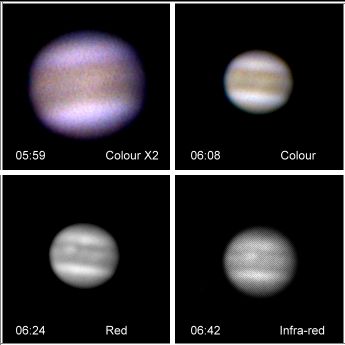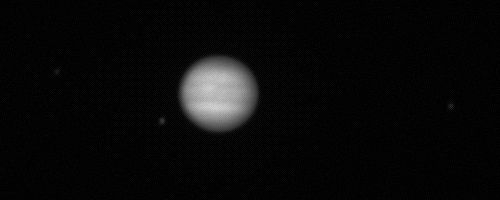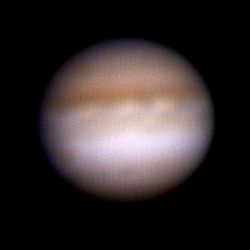 |
This was my first attempt of the season. Taken shortly before sunrise, Jupiter was at an altitude of only 11° when I took the first of these pictures, and 14° for the last. Atmospheric dispersion was gross for the colour pictures—Registax estimated a difference of 19 pixels between the red and the blue images in the X2 picture. This is not a problem with the monochrome images. The red filter is in fact a combination of filters (elsewhere I refer to them as my "poor man's H-α filter") which isolates a band of wavelengths between 650 and 700 nm. My IR filter is made from two layers of fogged colour film and passes very little light of wavelength <700 nm. The time at which each picture was taken is indicated below it, and you can see how much features on the planet had moved in the time between images. I have to romove my camera to change filters and it seems I didn't get it aligned correctly for the X2 image.
Date and Time: 4th February 2007 05:59 to 06:42 UT
Camera: ToUcam 740K (colour) and raw-modified Atik ATK-1 HS (monochrome)
Telescope: LX200
Capture: K3CCDTools. Low gamma exposures to suit
Processing: Registax. 239 to 458 frames stacked. Wavelets, gamma and histogram as appropriate |
|
|
 |
Taken the same morning, this is my attempt to image the satellites along with the planet. Not too successful, but they are there (Callisto was way out of frame to the east). I had to use a somewhat strange gamma curve to bring up the features on the planet without removing the satellites completely. Even so they are not easy to see on a dark monitor, so the mouseover image has had its gamma increased to 1.4 to make them more visible.
Date and Time: 4th February 2007 06:39 UT
Camera: Raw-modified Atik ATK-1 HS
Telescope: LX200 with IR-pass filter
Capture: K3CCDTools. High gamma, 1/25", 90% gain
Processing: Registax. 357 frames stacked. Wavelets 1-3 = 10, gamma as below, histogram 0-220
 |
|
| |
 |
I waited until July to try again. Jupiter moves very slowly though the stars and the nights got shorter and the skies more cloudy. Jupiter was still very low in the sky at only 16° when this image was made. It was taken with my Toucam 740K and I did manage to make an RGB image with my raw-modified Atik camera. Click on the image to see it and a picture showing the satellites.
Date and Time: 7th July 2007 22:34 UT
Camera: ToUcam 740K
Telescope: LX200 with X2 SLR lens
Capture: K3CCDTools. Low gamma, 1/33", 32% gain, 454 frames
Processing: Registax. 437 frames stacked. Wavelet 1-3 = 10, histogram 10-210, gamma as shown  |
|

